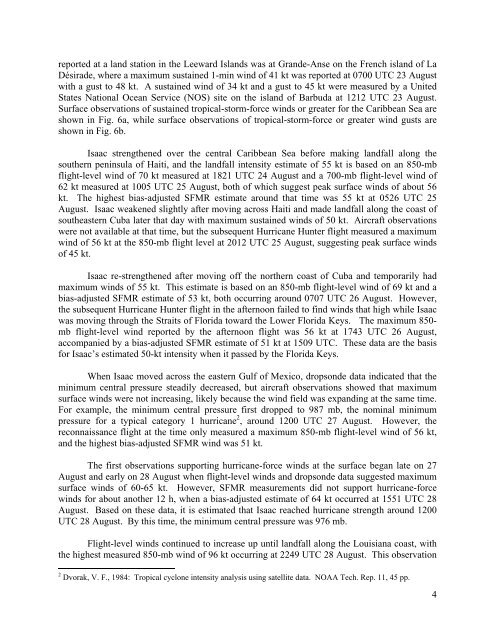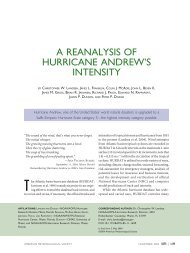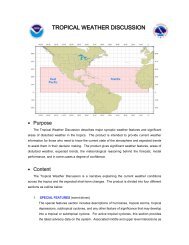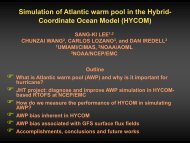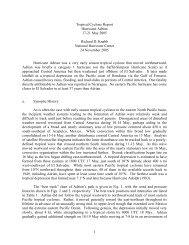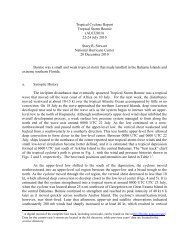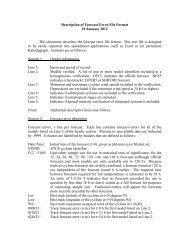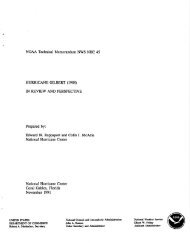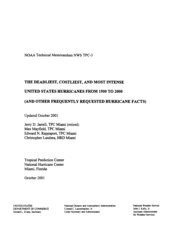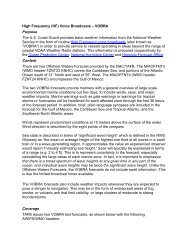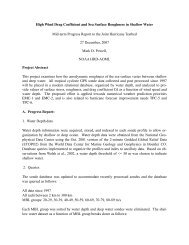Tropical Cyclone Report - National Hurricane Center - NOAA
Tropical Cyclone Report - National Hurricane Center - NOAA
Tropical Cyclone Report - National Hurricane Center - NOAA
Create successful ePaper yourself
Turn your PDF publications into a flip-book with our unique Google optimized e-Paper software.
eported at a land station in the Leeward Islands was at Grande-Anse on the French island of La<br />
Désirade, where a maximum sustained 1-min wind of 41 kt was reported at 0700 UTC 23 August<br />
with a gust to 48 kt. A sustained wind of 34 kt and a gust to 45 kt were measured by a United<br />
States <strong>National</strong> Ocean Service (NOS) site on the island of Barbuda at 1212 UTC 23 August.<br />
Surface observations of sustained tropical-storm-force winds or greater for the Caribbean Sea are<br />
shown in Fig. 6a, while surface observations of tropical-storm-force or greater wind gusts are<br />
shown in Fig. 6b.<br />
Isaac strengthened over the central Caribbean Sea before making landfall along the<br />
southern peninsula of Haiti, and the landfall intensity estimate of 55 kt is based on an 850-mb<br />
flight-level wind of 70 kt measured at 1821 UTC 24 August and a 700-mb flight-level wind of<br />
62 kt measured at 1005 UTC 25 August, both of which suggest peak surface winds of about 56<br />
kt. The highest bias-adjusted SFMR estimate around that time was 55 kt at 0526 UTC 25<br />
August. Isaac weakened slightly after moving across Haiti and made landfall along the coast of<br />
southeastern Cuba later that day with maximum sustained winds of 50 kt. Aircraft observations<br />
were not available at that time, but the subsequent <strong>Hurricane</strong> Hunter flight measured a maximum<br />
wind of 56 kt at the 850-mb flight level at 2012 UTC 25 August, suggesting peak surface winds<br />
of 45 kt.<br />
Isaac re-strengthened after moving off the northern coast of Cuba and temporarily had<br />
maximum winds of 55 kt. This estimate is based on an 850-mb flight-level wind of 69 kt and a<br />
bias-adjusted SFMR estimate of 53 kt, both occurring around 0707 UTC 26 August. However,<br />
the subsequent <strong>Hurricane</strong> Hunter flight in the afternoon failed to find winds that high while Isaac<br />
was moving through the Straits of Florida toward the Lower Florida Keys. The maximum 850mb<br />
flight-level wind reported by the afternoon flight was 56 kt at 1743 UTC 26 August,<br />
accompanied by a bias-adjusted SFMR estimate of 51 kt at 1509 UTC. These data are the basis<br />
for Isaac’s estimated 50-kt intensity when it passed by the Florida Keys.<br />
When Isaac moved across the eastern Gulf of Mexico, dropsonde data indicated that the<br />
minimum central pressure steadily decreased, but aircraft observations showed that maximum<br />
surface winds were not increasing, likely because the wind field was expanding at the same time.<br />
For example, the minimum central pressure first dropped to 987 mb, the nominal minimum<br />
pressure for a typical category 1 hurricane 2 , around 1200 UTC 27 August. However, the<br />
reconnaissance flight at the time only measured a maximum 850-mb flight-level wind of 56 kt,<br />
and the highest bias-adjusted SFMR wind was 51 kt.<br />
The first observations supporting hurricane-force winds at the surface began late on 27<br />
August and early on 28 August when flight-level winds and dropsonde data suggested maximum<br />
surface winds of 60-65 kt. However, SFMR measurements did not support hurricane-force<br />
winds for about another 12 h, when a bias-adjusted estimate of 64 kt occurred at 1551 UTC 28<br />
August. Based on these data, it is estimated that Isaac reached hurricane strength around 1200<br />
UTC 28 August. By this time, the minimum central pressure was 976 mb.<br />
Flight-level winds continued to increase up until landfall along the Louisiana coast, with<br />
the highest measured 850-mb wind of 96 kt occurring at 2249 UTC 28 August. This observation<br />
2 Dvorak, V. F., 1984: <strong>Tropical</strong> cyclone intensity analysis using satellite data. <strong>NOAA</strong> Tech. Rep. 11, 45 pp.<br />
4


